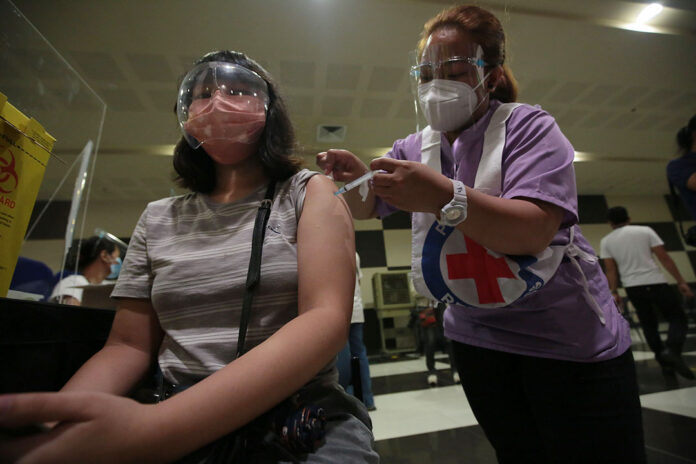A RESIDENT of Novaliches gets inoculated with a second dose of Coronavac. — PHILIPPINE STAR/ MICHAEL VARCAS
PHILIPPINE health authorities on Monday reported 411 more cases of the highly contagious Delta coronavirus variant, bringing the total to 3,798.
New Delta infections accounted for 55% of 747 samples tested up until last month, Health Undersecretary Maria Rosario S. Vergeire told an online news briefing.
She also said 88 more people had been infected with the Alpha coronavirus variant first detected in the United Kingdom, bringing the total to 2,935.
The country now has 3,307 cases of the Beta variant after 78 more Filipinos got infected with the strain first detected in South Africa.
The Department of Health (DoH) reported 8,292 coronavirus infections on Monday, bringing the total to 2.67 million.
The death toll rose to 39,660 after 36 more patients died, while recoveries increased by 302 to 2.54 million, it said in a bulletin.
There were 98,894 active cases, 74.4% of which were mild, 15.0% did not show symptoms, 3.2% were severe, 6.14% were moderate and 1.3% were critical.
The agency said 40 duplicates had been removed from the tally, 32 of which were reclassified as recoveries, while 21 recoveries were reclassified as deaths. Two laboratories failed to submit data on Oct. 9.
Ms. Vergeire said coronavirus infections in Metro Manila might further fall by the end of the month if the region remains under Alert Level 4.
Daily cases in the capital region could decrease to 1,731 if the second-highest alert level with a four-day detection-to-isolation time is enforced until Oct. 31, she said.
The daily tally could hit 3,605 under alert Level 3 with a similar detection-to-isolation period, Ms. Vergeire said.
Daily cases would be higher at 2,195 under Alert Level 4 if the detection-to-isolation period is six days, and as many as 4,557 under Alert Level 3, she added.
“This further supports our call to focus on reducing the time between detection and isolation and to not only rely on measures that restrict mobility,” Ms. Vergeire said.
While the coronavirus situation in Metro Manila has improved, the Cordillera Administrative Region, Cagayan Valley and Zamboanga Peninsula remained at high risk classification, with health care capacities at high to critical risk.
“While we see improvement in our case trends, this is not the time to be complacent,” she said.
Last week, Ms. Vergeire said there had been fewer swab tests for the coronavirus in 14 regions including Metro Manila.
The biggest decline in RT-PCR tests was in the capital region, where the positivity rate fell to 16.4% in the past week from 19.3% a week earlier, she said.
Swab tests in the metro fell by 37,383 or 14.1% to 266,042, leading to fewer people who tested positive for the virus, she added.
Manila, the Philippine capital and nearby cities might become at low risk from the coronavirus by the end of October amid decreasing infections, the OCTA Research Group said on Sunday.
Virus cases in the capital region have peaked at a seven-day average of 2,000, Octa fellow Fredegusto P. David told ABS-CBN’s Teleradyo.
Hospital occupancy in Metro Manila was also expected to decline, he said, adding that the national daily average could fall to less than 10,000 in the coming weeks from 11,000 now.
The capital region now had a COVID-19 reproduction number of 0.6, or the number of people infected by a single virus patient, while the positivity rate was 13%, Mr. David said.
He traced declining infections to herd immunity. At least half of the capital region’s adult population has been fully vaccinated against the coronavirus.
The Philippines last week recorded daily virus cases of fewer than 10,000 for two straight days.
The Health department earlier cited a downtrend in virus cases in Metro Manila, even as cases increased in the Bicol, Mimaropa and Zamboanga Peninsula regions. — Kyle Aristophere T. Atienza

